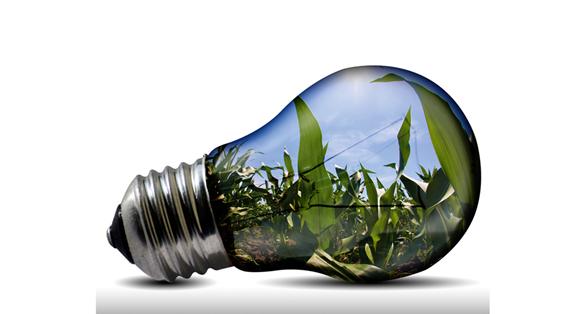
Everyone knows that CFLs and LEDs offer more lumens per watt than an incandescent lamp,but less is known about the lifecycle performance of the newer technologies–including manufacture and disposal.Nick Martindale looks at exhaustive new research by the US Department of Energy into this aspect
In recent years the move to replace incandescent lamps in homes and businesses with alternative CFL and LED-based products has been accelerated by increased legislation banning the production of the older light sources.
The principal reasoning behind such legislation has been that the newer technologies offer similar levels of performance but use a fraction of the energy,and thus are more sustainable.This was borne out earlier this year in a report by the US Department of Energy:Life Cycle Assessment of Energy and Environmental Impacts of LED Lighting Products,the result of an exhaustive programme of tests on LED lighting products.
Part 1 of the report found that the two newer technologies were broadly comparable in the energy they consumed while in use,which was about a quarter of that used by incandescents.
Part 2 of the report addressed doubts that lingered over the sustainability of the newcomers.What was the true life cycle performance–including the manufacture and disposal–of compact fluorescents and LEDs?The inclusion of mercury in CFLs has led to strict controls over their recycling,while relatively little was known about the full environmental impact of manufacturing and disposing of LEDs.
"The US Department of Energy commissioned the report to help educate the lighting community about LEDs and lighting choices,"says Heather Dillon,senior research engineer at the Pacific Northwest National Laboratory,which undertook the research.
"It aimed to consider all aspects of a lamp's life cycle from the raw material used to make the LEDs,circuits and bulbs through manufacturing,transport,use of the lamp by the customer and finally disposal."
Taking all these elements into account,CFLs,LEDs and incandescents were compared against 15 key metrics,assessing the impact they had on the environment–resources,air,soil and water–using the score of the worst-performing technology as a benchmark comparator.
The researchers found that both CFLs and LEDs were far superior to incandescent lamps in their environmental performance and,while there was relatively little to choose between LEDs and CFLs,LEDs outperformed CFLs in all but one of the 15 categories(see figures 1-1 and 1-2).
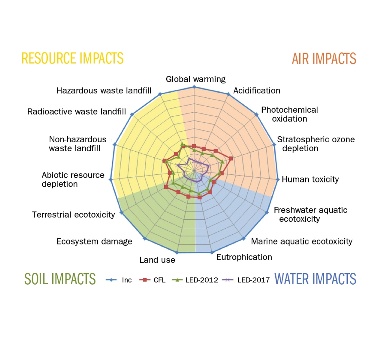
Figure 1-2(below)presents the same results as 1-1(above)but adjusted to remove the incandescents and show the impacts relative to those of compact fluorescents
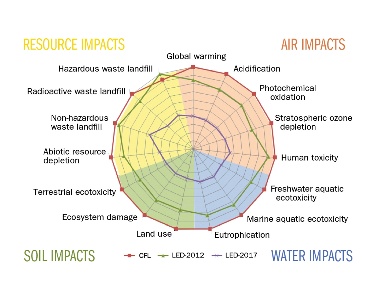
The study also looked beyond the current generation of LEDs to evaluate both these and CFLs against the expected future performance of LEDs in 2017,drawing on targets,forecasts and research from the US Department of Energy's own'multi-year program plan'(MYPP)for improvements in solid-state lighting,which was conducted in collaboration with the Next Generation Lighting Industry Alliance.
The next generation
"We are very confident that LEDs will be performing at this level by 2017,since many of the assumptions used for the 2012 product were very conservative,"says Dillon."Several of our external reviewers are manufacturers and they said the 2017 projection was aligned with the MYPP and is reasonable."
The survey predicts that the environmental impact of LED lamps in 2017 will be about 70 per cent lower than today's CFLs and approximately 50 per cent less than the current generation of LEDs.A major reason for this is reduction by 2017 in the amount of aluminium sink included within LEDs.
Aluminium is extremely energy-intensive to manufacture and is the main reason why today's LEDs are outperformed by CLFs in the category of hazardous waste to landfill.The amount of aluminium in LEDs is anticipated to fall by 49 per cent over the next five years.
"The aspect which surprised us most was the rapid pace of change in the LED industry,"says Dillon."Manufacturers are improving production processes almost daily,and we made conservative estimates for many assumptions based on data which may already be out of date.The LEDs of tomorrow may already be out on retail shelves."
Comparative sustainability
The survey also found that the overwhelming majority of a lamp type's energy usage was accounted for by its operation,rather than by the manufacturing processes or packaging used for the product(see figure 2-1 below).
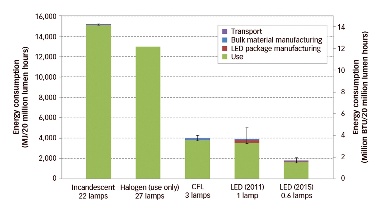
Figure 2-1
A comparison of the overall global warming potential of the four types of lamp again starkly illustrates the lower environmental impact of LEDs and CFLs compared with incandescents,and the predominance of next-generation LEDs in particular(see figure A-1 below).
It was a similar story when it came to hazardous waste and its impact on landfill,although it is worth noting the narrower gap between all four technologies(see below for figures A-2 and A-3).
The research only compared like-for-like products that operated in a 120V US mains socket,says Dillon,so it did not explore the implications of recycling fittings with integrated LEDs.She says:"We expect that recycling practices will improve as more of these lamps are sold.But one of the subtle conclusions of the study is that,since the[lifetimes]of CFLs and LEDs are so much longer,even if recycling is not widespread,choosing these lighting options offers significant upstream reductions in landfill waste."
Dillon adds that the second part of the survey drew on data that already existed on the construction and life cycle of lamps,giving equal emphasis to the various stages.She says:"One of the unique aspects of this report is that we developed and described each unit process in the manufacturing steps of an LED and then we used those pieces to build the full life cycle picture.This was challenging,as LED manufacturers are secretive,due to the proprietary nature of the work."
Product testing
Manufacturers did,however,review the processes the researchers were using to assess products and the study also drew on the experience of other life cycle assessment researchers in Europe.
A yet-to-be-compiled final part of the US Department of Energy's study will perform physical tests based on EPA protocols to determine end-of-life implications for the various lighting products and this will be available in the autumn.
But,from what has been published so far,the overall message is clear.
"We all need[artificial]light to function,and it is really just a question of choosing the right light source,"says Dillon."In this case we feel the choice of a CFL or LED is a clear winner,compared to incandescent,for the consumer and for the environment and in the future an LED lamp will become the best choice."
The second part of the department's report can be downloaded in PDF format through the following link:http://apps1.eere.energy.gov/buildings/publications/pdfs/ssl/2012_led_lca-pt2.pdfEnvironmental impacts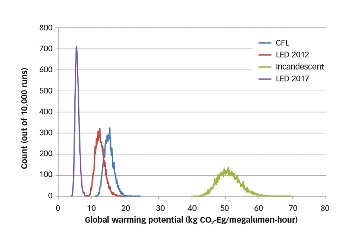
Figure A-1
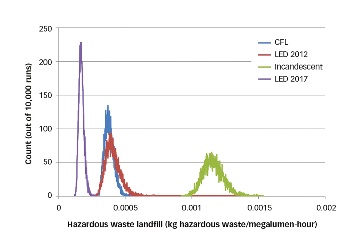
Figure A-2

Figure A-3
The graphs above show the final output of a Monte Carlo analysis of the different lamp technologies.
A Monte Carlo graph shows a distribution of results rather than a single-point result.By plotting histograms of distributions for the different lamp types analysed,it is possible to determine,by the amount of overlap,a level of confidence in the results.
Fig A-1 shows the future global warming potential of the four types.Figs A-2 and A-3 show that 2012 LEDs have slightly more impact on the environment than CFLs.





